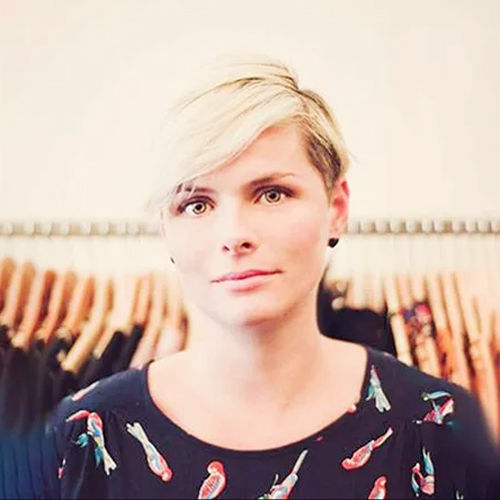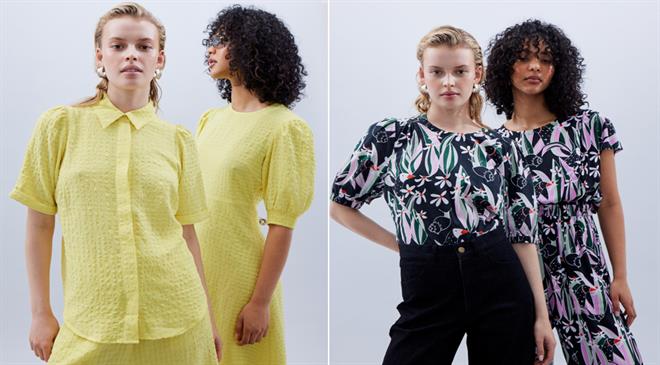
Amanda McCarthy
Designer
Label - Leonard Street
I find inspiration in nature and art
Leonard Street is an Australia-based clothing brand by Amanda McCarthy. The pairing of gorgeous illustrations or geometric patterns with chic colour palettes is part of what makes Leonard Street one of Melbourne’s most loved ethical clothing brands. In an interview with Fibre2Fashion, the designer discusses about her journey, digital world and Australian fashion Industry.
Fibre2Fashion: What attracted you towards the fashion industry and how would you describe your journey?
Amanda McCarthy:
I have always loved fashion and fell into fashion retail after studying ceramics design. My journey has been very instinctive, and I have worked in many areas of clothing, from retail, visual merchandising, costuming and styling. I started my own label in 2004, when I was 29 years old.
F2F: How would you define the aesthetic of your collection?
AM:
Expressive, embraces colour and print, with a nod to vintage silhouette. It’s a fresh take to empower women and evoke joy.
F2F: Where do you get your creative nutrition? What fashion do you follow?
AM:
I find inspiration in nature and art. I don’t really follow fashion trends, but I am not afraid to commit to an aesthetic. I am inspired by texture and the ability of garments to have strong memories or associations, and truly lift one’s spirits.
F2F: What are your thoughts on the fashion industry’s switch towards digital and metaverse world?
AM:
Every industry has become digitally accessible, and the globe has become smaller in a sense, and fashion is no different. The downside is the fast fashion’s ability to oversaturate the market, but the upside is individual design and quality workmanship which shines through.
F2F: Could you brief about fashion industry in Australia? How has it evolved over the years?
AM:
The Australian fashion industry has changed a lot over the years. My grandfather made womenswear in Flinders Lane in the heart of Melbourne in the 1930s, under his label Laurie McCarthy. He had a floor behind Herald Sun building with a dozen sewing machines, a cutting table, a showroom, rolls of fabric, and lots of corners for me to dream in. My father John and Uncle worked there, and my Aunty was the designer. I loved the French pattern cutter Mary with her beautiful accent, and my favourite seamstress was Gwen. My grandfather supplied Georges and many suburban and country boutiques. But that way of trade is a thing of the past. I am grateful I was able to sell on consignment in Melbourne boutiques like Alice Euphemia and Fat52, when I was launching my brand. It gave me great insight into retailing, demand and costs. Now with e-commerce becoming a dominant force in fashion retailing, that business model is fading. It’s hard to survive in this industry, but with passion and a strong point of difference, it is possible. However, my focus will always be on quality, craftsmanship and sustainable practices.
F2F: How do you include sustainability in your fashion creations?
AM:
I make sustainable choices wherever I can in all aspects of business—from production practices to packaging and freight. We use all leftover fabrics to make accessories or childrenswear. It’s not a profitable line but it means the textiles do not go to waste. Since so much work goes into developing and printing, I would hate to see any leftovers going to waste. We achieve our Zero Waste goals this way. So, for items like scrunchies, jewellery pouches, garlands, belt ties and the childrenswear line, we use excess or imperfect print. I don’t use any plastic packaging in my garments; they all come tied together in fabric stripes – also offcuts from our production process. We send goods by sea freight to reduce our carbon footprint. I choose organic cotton, sustainable bamboo jersey and hemp, and increasingly available recycled yarns, which is so exciting. This will be a growth area.
F2F: What are you currently working on?
AM:
I am currently working on a new accessory line made from pineapple leather and cactus leather which I am super excited about.

Rahul Mehta
Gabi Seligsohn
Rahul Mehta
Fanny Vermandel
Pradip Mehta
Aseem Prakash
Bill D’Arienzo
Anurag Batra
Arun Sirdeshmukh
Abhay Gupta





_8.JPG)







